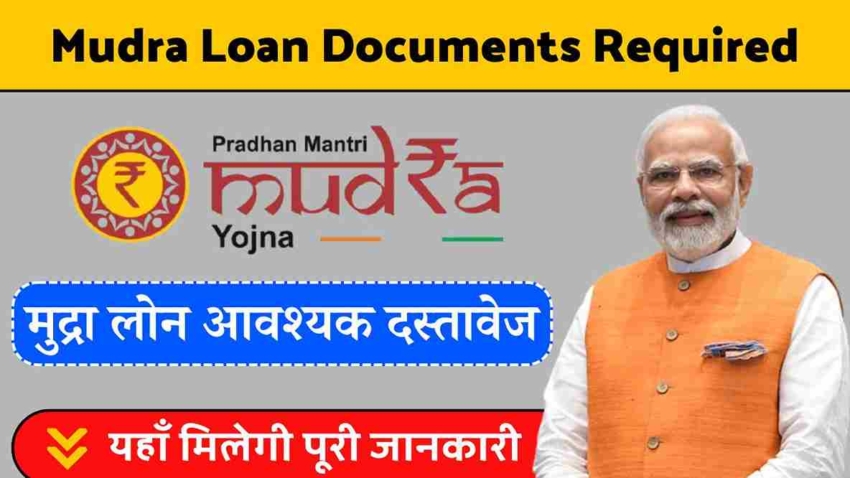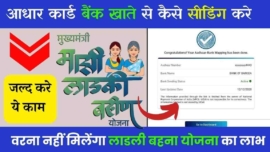
Mudra Loan Documents Required 2024: How to Prepare Your Documents for Fast Approval
In India, the Pradhan Mantri Mudra Yojana (PMMY) was launched in 2015 to provide financial assistance to micro and small enterprises. Under this scheme, loans up to ₹10 lakh are offered to eligible applicants without the need for collateral. If you’re looking to apply for a Mudra loan, it is important to understand the documents required for a smooth application process. This guide outlines the essential documents and the steps needed to ensure your application is processed quickly.
1. Introduction to Mudra Loan
The Pradhan Mantri Mudra Yojana was initiated to empower micro, small, and medium enterprises (MSMEs) in India by providing easy access to financial resources. Mudra loans are available under three categories: Shishu, Kishore, and Tarun, depending on the size and stage of the business. Each category has different financial limits and requirements, but the documentation process remains fairly consistent across the board.
2. Types of Mudra Loans
- Shishu Loan: For startups and small businesses, loans up to ₹50,000 are provided.
- Kishore Loan: For businesses that are already established but need additional funding, loans from ₹50,001 to ₹5 lakh are available.
- Tarun Loan: For larger businesses requiring significant capital, loans from ₹5 lakh to ₹10 lakh can be sanctioned.
Each loan type has specific documentation requirements, but some documents are universally required for all categories.
3. Eligibility Criteria for Mudra Loans
Before you begin gathering documents, it’s important to confirm your eligibility for a Mudra loan. Key eligibility criteria include:
- The applicant must be an Indian citizen.
- Businesses involved in manufacturing, trading, and service sectors can apply.
- Both new and existing businesses can avail of the loan.
- Only non-corporate, non-farm small/micro enterprises are eligible.
Once you confirm that your business meets these criteria, the next step is preparing the necessary documents.
4. Documents Required for Mudra Loan Application
Here’s a detailed breakdown of the documents you’ll need to submit when applying for a Mudra loan.
4.1 Personal Identification
Personal identification documents are mandatory for verifying the applicant’s identity. The most commonly accepted documents include:
- Aadhaar Card: Acts as both identification and address proof.
- Voter ID: Useful for additional identification.
- PAN Card: Required for taxation and financial history verification.
- Passport: If applicable, for identity proof.
- Driving License: Often used as supplementary identity proof.
4.2 Proof of Business Existence
You will need to provide proof that your business is legitimate and has been operational. Acceptable documents include:
- Business Registration Certificate: Whether your business is registered as a proprietorship, partnership, or private limited company, the certificate is crucial.
- Partnership Deed (if applicable): For businesses that are run in partnership.
- Sales Tax or VAT Registration: For tax compliance.
- Shop Establishment Certificate: For businesses with physical locations.
4.3 Business Financial Statements
To evaluate the financial stability of your business, lenders will require:
- Income Tax Returns (ITR): Usually for the last two years.
- Balance Sheet: A detailed balance sheet of the last two financial years.
- Profit & Loss Statement: To show the profitability of your business.
- Audited Financials: If applicable, for larger loan amounts, audited financials can strengthen your application.
4.4 Bank Statements
The applicant must submit bank statements to help the lender assess the business’s financial health and liquidity.
- Bank Account Statements: The statements from the last 6 to 12 months are usually required. They give insight into your financial activities and the cash flow of your business.
4.5 Other Relevant Documents
Depending on the nature of your business and the lender’s specific requirements, additional documents may be requested, such as:
- Proof of Address: If the business operates from rented premises, a rent agreement or utility bill is necessary.
- Quotation of Machinery or Equipment: If the loan is being used for purchasing equipment, a detailed quote must be provided.
- Project Report: For new businesses, a project report detailing the business plan, revenue models, and growth projections is often requested.
5. How to Apply for a Mudra Loan
The application process for a Mudra loan is relatively simple but must be followed carefully:
- Visit the bank or financial institution: Mudra loans can be applied through most public and private sector banks, regional rural banks, and NBFCs.
- Fill out the Mudra loan application form: The form asks for basic details about the applicant, the business, and the loan amount required.
- Submit the necessary documents: All the documents mentioned above should be ready and submitted along with your application.
- Wait for approval: The bank will review your application, and if everything is in order, the loan will be sanctioned. The process typically takes a few days to a couple of weeks, depending on the loan amount.
6. Common Mistakes to Avoid
Many Mudra loan applications are delayed or rejected due to errors or missing documents. To avoid any setbacks, be sure to:
- Double-check that all forms are filled out accurately.
- Provide copies of every document requested by the bank.
- Ensure that all financial statements and tax returns are up to date.
- Provide a clear business plan if applying for a Kishore or Tarun loan.
- Be transparent about the purpose of the loan.
7. Conclusion
Understanding and gathering the required documents is the key to a smooth and hassle-free Mudra loan application process. Whether you’re starting a new business or looking to expand an existing one, preparing the necessary documents ahead of time can significantly speed up the approval process.
In 2024, as the demand for Mudra loans continues to grow, ensuring that you are well-prepared with the correct documents can make all the difference. Whether you’re applying for a Shishu, Kishore, or Tarun loan, following the outlined steps will improve your chances of securing the funding you need to drive your business forward.
By following these guidelines and having all the necessary documents ready, you can increase your chances of a successful Mudra loan application. The Pradhan Mantri Mudra Yojana is an excellent opportunity for small business owners in India to access financial resources without the burden of heavy collateral. Prepare well, apply early, and take your business to new heights!
FAQs on Mudra Loan Documents Required
What is the Mudra Loan?
Mudra Loan is a financial scheme under the Pradhan Mantri Mudra Yojana (PMMY) that provides loans up to ₹10 lakh to small and micro enterprises in India without requiring collateral. The loan is categorized into three types: Shishu, Kishore, and Tarun, based on the funding needs of the business.
Who is eligible to apply for a Mudra Loan?
Individuals who own small or micro enterprises involved in manufacturing, trading, or services can apply for a Mudra Loan. The applicant must be an Indian citizen, and the business should fall within the non-farm, non-corporate small business category.
What are the documents required for a Mudra Loan?
The essential documents include:
Personal identification (Aadhaar Card, PAN Card, Passport, etc.)
Proof of business existence (Business Registration Certificate, Partnership Deed, Shop Establishment Certificate)
Business financial statements (ITR, Balance Sheet, Profit & Loss Statement)
Bank statements (last 6-12 months)
Address proof (Rent Agreement, Utility Bill) if required
Do I need to provide collateral for a Mudra Loan?
No, Mudra Loans are collateral-free, meaning you don’t have to provide any assets as security to avail of the loan.
Can I apply for a Mudra Loan online?
Yes, many banks and financial institutions offer the option to apply for a Mudra Loan online. You can visit their official websites and submit the required forms and documents digitally.
What is the maximum loan amount under the Mudra scheme?
The maximum loan amount available under the Mudra scheme is ₹10 lakh. Loans are divided into three categories:
Shishu: Up to ₹50,000
Kishore: ₹50,001 to ₹5 lakh
Tarun: ₹5 lakh to ₹10 lakh
How long does it take to get a Mudra Loan approved?
The approval process for a Mudra Loan generally takes between 7 to 10 working days, depending on the lender and the completeness of the documents submitted.
Is there any processing fee for Mudra Loans?
Many lenders, especially public sector banks, do not charge a processing fee for Shishu and Kishore Mudra Loans. However, some private banks and NBFCs may charge a small fee for larger loan amounts like the Tarun category.
What is the interest rate for Mudra Loans?
The interest rate on Mudra Loans varies based on the lending institution and the loan category (Shishu, Kishore, Tarun). Typically, the rates range between 8% to 12% per annum.
Can I use the Mudra Loan to start a new business?
Yes, Mudra Loans can be used to start a new business, particularly under the Shishu category, which provides up to ₹50,000 for startups and new enterprises.
Do I need to submit a project report for a Mudra Loan?
For Kishore and Tarun loan categories, a project report may be required, especially if the loan amount is significant. The report should detail the business plan, revenue projections, and how the loan amount will be utilized.
Can a self-employed person apply for a Mudra Loan?
Yes, self-employed individuals involved in non-farm activities, such as retail trade, manufacturing, and service sectors, can apply for a Mudra Loan.
Do I need a guarantor for a Mudra Loan?
No, Mudra Loans do not require a guarantor since they are collateral-free loans. However, having a strong credit history can improve your chances of approval.
Can I apply for a second Mudra Loan if I’ve already availed one?
Yes, you can apply for a second Mudra Loan under the Kishore or Tarun category if you have already availed of a Shishu loan or repaid your first loan successfully.
What is the repayment period for a Mudra Loan?
The repayment period for Mudra Loans ranges from 1 to 5 years, depending on the loan amount and the terms set by the lender. Some banks may also offer a moratorium period.















